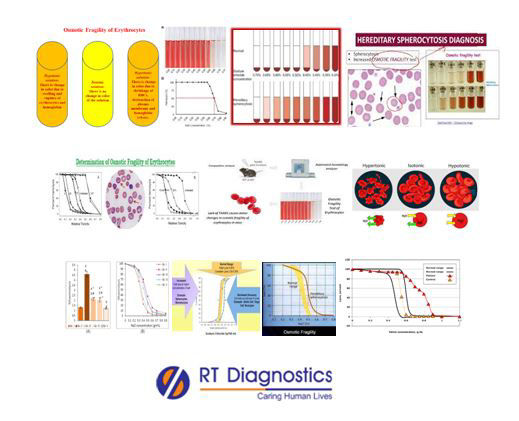Osmotic Fragility Test – RBC:
Why Osmotic Fragility Test?
CLINICAL INFORMATION
Osmosis is the spontaneous passage (net movement) or diffusion of water and/or other solvents through a selectively permeable membrane till equilibrium (equalising the solute concentrations on both sides) is achieved. The movement of water molecules from higher concentration (higher water potential with lower solute concentration) to lower concentration (lower water potential with higher solute concentration) through the cell (semipermeable membrane) membrane. This biological membrane is selectively permeable to hydrophobic or non-polar molecules like lipids, oxygen, carbon dioxide, nitrogen, nitric oxide etc, while are impermeable to large and polar molecules such as ions, proteins, polysaccharide etc.
Osmotic pressure (which depends on absolute temperature and the molar concentration of the solute) is the external pressure required to be applied so that no net movement of a solvent across the membrane. Hence osmotic pressure is the minimum pressure which is needed to be applied to a solution to prevent the inward flow of its pure solvent across the biological (semipermeable) membrane. Turgor pressure (the force within the cell that pushes the plasma membrane against the cell wall) of a cell is largely maintained by osmosis across the cell membrane between the cell (interior and its relatively hypotonic environment). Hence in living things the osmotic entry of water raises the turgor pressure exerted against the cell wall, till the osmotic pressure attains equilibrium creating a steady state. Therefore this osmotic balance is the control of water and electrolyte balance in the body. Moreover, oncotic pressure (colloid osmotic pressure) is a form of osmotic pressure created by the proteins (mainly by albumin), in the blood vessel that causes suction pressure on the fluids back into the capillary. Hence serum albumin and proteins in plasma (blood) help to maintain osmotic pressure between blood vessels and tissues. The excess electrolytes, including other metabolic end-products that result from osmoregulation, are transported to the kidneys and are excreted, thus helping to maintain osmotic balance.
Normal RBC is the relatively impermeable biconcave disc which maintains osmotic equilibrium with the surrounding medium. When erythrocytes are placed in a hypotonic solution (NaCl – sodium chloride), water enters the RBCs to maintain stability. When the RBCs are exposed to very hypotonic (NaCl) solutions they fill to maximum capacity and eventually rupture. The osmotic Fragility test is the functional testing of RBC sensitivity to osmotic stress. The osmotic Fragility test in erythrocytes is a composite index of their shape, hydration and within certain limitations their proneness (susceptibility) to in vivo destruction. Thus this test is used to measure the RBC’s resistance to hemolysis when exposed to different concentrations of saline solution. Osmotic Fragility Test (propensity of RBCs: detects if the erythrocytes are prone to lysis) helps to diagnose abnormal hereditary conditions like thalassemia (with abnormal haemoglobin), spherocytes etc. This test serves to distinguish hereditary spherocytes from auto-immune hemolytic anaemia in a differential diagnosis. High osmotic fragility shows the erythrocyte’s decreased capacity to expand, hence tends to rupture easily due to mechanical stress (different concentrations of the hypotonic solution – NaCl). Low fragility test results indicate RBC’s stability due to the resistance offered due to stress-induced lysis and/or spontaneous autolysis. These tests also help in blood transfusion and blood banking (storage). Symptoms of anaemia are fatigue, dizziness, shortness of breath, palpitations etc. Additional tests haemoglobin electrophoresis, MCH Test, MCV, reticulocyte count etc. Other tests Include CBC, flow cytometry, ferritin and iron tests, vitamin B12 and folic acid tests etc.

General Instructions:
Sample Requirement: Specimen - Blood sample collected from the vein. Test Preparation: None.
NOTE - Sample for specimen collections may vary based on the patient’s condition/cases according to the patient’s presenting complaints/signs or symptoms:
SPECIMEN REQUIREMENT (Special or Rare Cases) - As instructed and guided by Physician / Clinician / Pathologist / as per Laboratory’s requirements, according to procedures and protocols.
This Multi-Specialty Clinical Referral Laboratory RT DIAGNOSTICS provides precise and accurate tests with an extensive range of testing services to the medical centres to help in the diagnosis and identification of pathology in the test specimens for infectious diseases and also to evaluate the function of organ systems of the patient. It prevents further complications and helps to stabilize and restore health to near normalcy at the earliest without delay.



